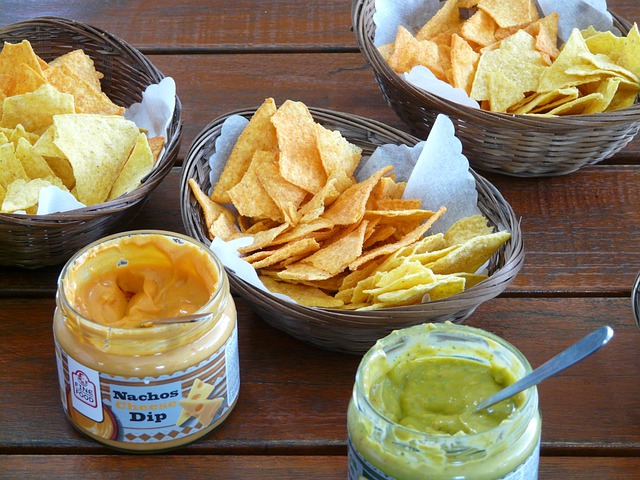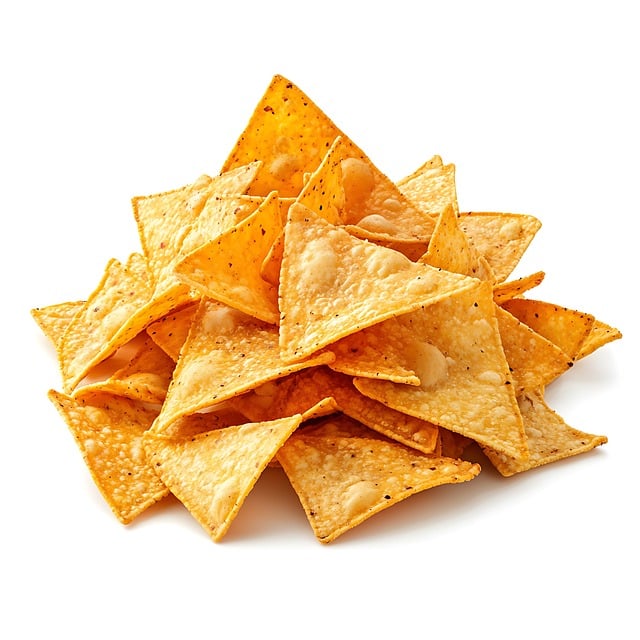Handcrafted tortilla chips, a cornerstone of authentic Mexican dining, represent an artistic tradition celebrated for generations. Their core mission revolves around achieving the perfect balance between crisp texture and nuanced flavor, with each chip capturing the essence of fresh corn and minimal ingredients (corn, oil, salt). Skilled chefs meticulously hand-cut each chip, resulting in a delicate crunch and subtle charred edges that distinguish them from machine-made alternatives. Top restaurants prioritize quality control, ensuring consistent perfection through meticulous preparation methods and careful sourcing. These handcrafted chips not only enhance the dining experience but also foster customer loyalty by showcasing the rich cultural heritage of Mexican cuisine.
“Uncover the secret behind the crispy, golden perfection of handmade tortilla chips—a culinary cornerstone of Mexican restaurants. This article delves into the art, ingredients, and methods that transform simple corn or wheat flour into a game-changing side dish. From traditional hand-rolling to modern cooking techniques, we explore how quality control ensures consistency, enhancing customer experiences and fostering brand loyalty. Discover the mission of authentic tortilla chips and their enduring impact on Mexican cuisine.”
- Understanding the Art of Handmade Tortilla Chips
- The Basic Ingredients and Their Role
- Traditional vs Modern Preparation Methods
- Quality Control and Consistency in Mexican Restaurants
- The Impact on Customer Experience and Loyalty
Understanding the Art of Handmade Tortilla Chips

Handmade tortilla chips are more than just a side dish in Mexican restaurants; they represent an art form passed down through generations. The basic tortilla chip mission is to achieve a perfect balance between crispness and flavor, capturing the essence of fresh corn and simple ingredients. This traditional method involves hand-rolling dough into thin, circular shapes, then frying them to perfection, resulting in chips that are light, crispy, and subtly sweet.
The craftsmanship behind each batch ensures consistency in quality and taste, making handmade tortilla chips a standout choice for any authentic Mexican dining experience. By embracing this time-honored tradition, restaurants not only provide customers with a delightful sensory experience but also uphold the cultural heritage that defines Mexican cuisine worldwide.
The Basic Ingredients and Their Role

The foundation of any great tortilla chip lies in its simple yet essential ingredients. Corn, oil, and salt are the core components that transform into the classic, crispy chips we all love. The basic tortilla chip mission is to capture the essence of Mexican cuisine with every bite—a taste of home, if you will.
Corn, being the star ingredient, provides the quintessential texture and flavor profile. When ground into a dough, treated with care, and cooked to perfection, it forms the perfect base for chips that are light, crispy, and satisfying. Oil, another crucial element, ensures these chips achieve their golden-brown color and crispiness without compromising on taste or quality. A pinch of salt completes the picture, enhancing both the natural flavors and inviting a delightful crunch with every dip.
Traditional vs Modern Preparation Methods

In the traditional preparation method, making tortilla chips involves a labor-intensive process where skilled chefs hand-cut each chip from soft tortillas, ensuring uniform thickness and size. This technique, though time-consuming, results in crispy, golden-brown chips with a distinct texture and flavor that are beloved by many. It’s a basic tortilla chips mission to capture the authentic taste of Mexico, where every bite echoes the bustling streets and vibrant culture.
Modern preparation methods, on the other hand, have revolutionized the way tortilla chips are made. With advancements in technology, commercial machinery now cuts and fries massive batches of tortillas, achieving consistent quality at a faster pace. While this approach may streamline production, it often lacks the artisanal touch that comes from handcrafted chips. For purists, nothing beats the delicate crunch and subtle charred edges that come from traditional preparation, making hand-made tortilla chips a quintessential part of the authentic Mexican dining experience.
Quality Control and Consistency in Mexican Restaurants

In the realm of Mexican cuisine, consistency and quality control are non-negotiable, especially when it comes to beloved staples like basic tortilla chips. Restaurants that take pride in their chip offerings understand that every bite should evoke a familiar, comforting taste—a true testament to their culinary craftsmanship. To achieve this, meticulous attention is paid during the hand-making process, ensuring each chip maintains the perfect balance of crispness and texture. This commitment to quality starts with carefully sourced ingredients and ends with precise cooking techniques, guaranteeing a uniform experience for every customer.
Consistency in chip preparation ensures that every diner can expect the same delightful crunch and subtle corn flavor, regardless of their visit time or server. It’s this dedication to maintaining standards that sets apart top-tier Mexican restaurants, where even seemingly simple dishes like tortilla chips are elevated to a level of excellence, leaving folks craving more.
The Impact on Customer Experience and Loyalty

Handmade tortilla chips, a simple yet integral part of many Mexican restaurants, significantly enhance the customer experience and foster loyalty among patrons. Beyond their delicious taste, these chips represent a unique culinary tradition that sets apart establishments from chain competitors. The process of making them by hand, often in front of customers, adds an element of theatre to dining—a spectacle that captivates folks and creates a memorable impression.
This personal touch resonates with diners who appreciate the artistry and effort invested in preparing their snacks. As a result, customers are more inclined to return, seeking not just the familiar flavors but also the consistent quality and authentic experience associated with homemade tortilla chips. In essence, these chips have become a basic component of the Mexican restaurant’s mission, contributing to a loyal customer base that cherishes both the cuisine and the ambiance.
Handmade tortilla chips have become a defining element of authentic Mexican dining experiences. By understanding the art, ingredients, and preparation methods, modern Mexican restaurants can ensure quality control and consistency, ultimately enhancing customer loyalty and fostering a deeper connection to traditional flavors. These delicate, yet vital, chips are more than just a side dish; they’re a symbol of culinary craftsmanship that reflects the basic tortilla chip mission: to deliver a taste of Mexico with every bite.
